Updated 02/2019 | Download PDF
INTRODUCTION
Currently, 1.9 million people are living with limb loss in the United States, with an average of 507 people continuing to lose a limb every day. This results in an estimated 185,000 amputations per year (1), and this number is expected to double by the year 2050 due to increasing rates of diabetes and vascular disease (1). Among those living with limb loss, the major causes of their amputations are vascular disease (54%) – including diabetes and peripheral arterial disease – trauma (45%) and cancer (less than 2%) (2). The most common causes of pediatric amputations, however, are lawn mower accidents (3). Non-whites comprise about 42% of the limb loss population in the U.S. (1). In 2008, the diabetes related amputation rate among African Americans was nearly four times that of whites (4).
A total of 522 amputations were performed in Rhode Island hospitals in 2014. These amputations were performed for a variety of reasons, including diabetes and peripheral arterial disease complications. The following information details the trends and most current rates of amputation and diabetes in Rhode Island.
1. AMPUTATION TRENDS
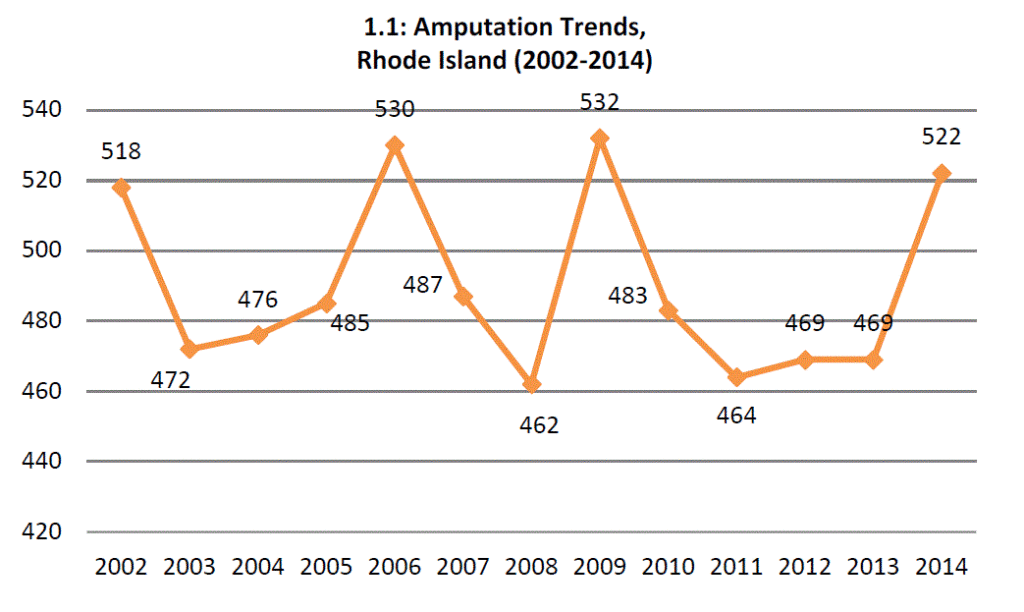
SOURCE: HEALTHCARE COST AND UTILIZATION PROJECT HCUPNET DATABASE HCUPNET.AHRQ.GOV
The number of total amputations performed in Rhode Island increased 0.77% from 2002 to 2014 according to hospital discharge data. A total of 5,900 procedures were performed in this time period. After a low of 462 in 2008, the number of amputation rose to 522 in 2014. (See Graph 1.1)
The number of upper-extremity amputations performed each year ultimately increased 16.13% from 2002 to 2014. A total of 429 of these procedures were performed in this time period. The lowest incidences of these amputations (25) occurred in 2011, while 2009 saw the most upper-extremity amputations (45) in this time period. (Graph 1.2)
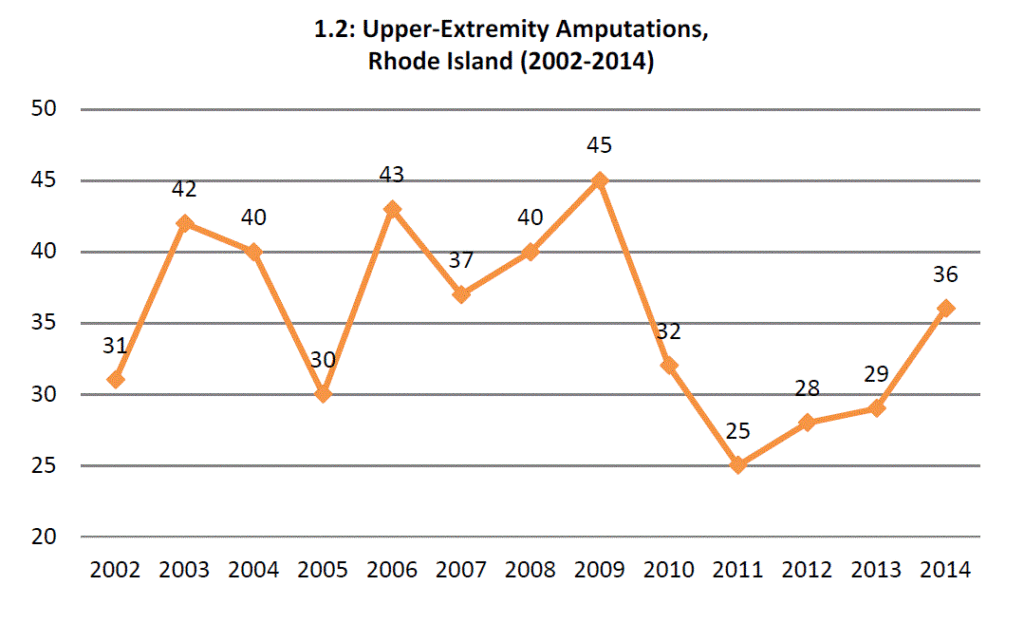
SOURCE: HEALTHCARE COST AND UTILIZATION PROJECT HCUPNET DATABASE HCUPNET.AHRQ.GOV
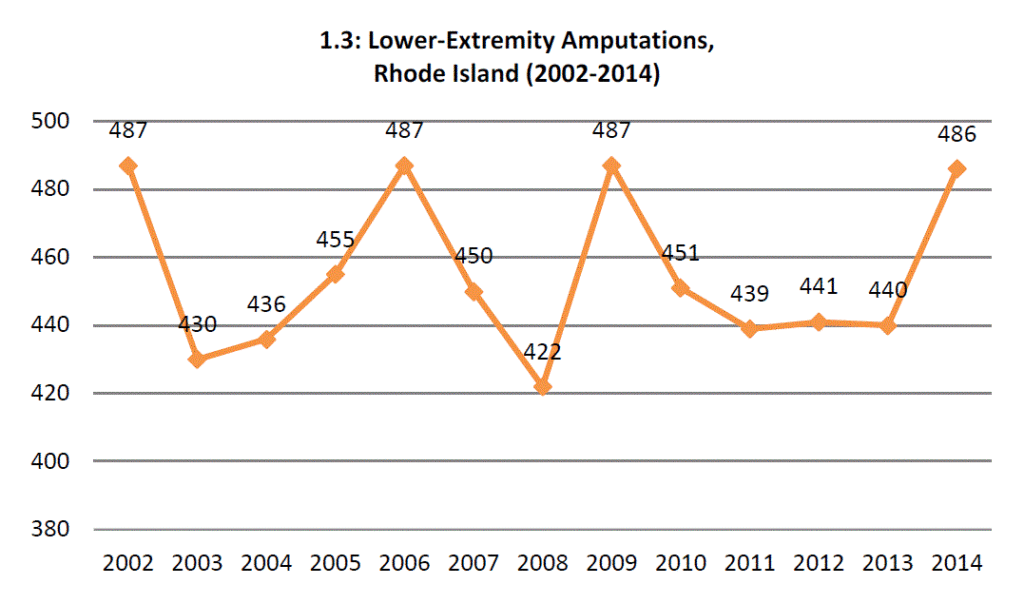
SOURCE: HEALTHCARE COST AND UTILIZATION PROJECT HCUPNET DATABASE HCUPNET.AHRQ.GOV
From 2002 to 2014, a total of 5,471 lower-extremity amputations were performed in Rhode Island. The lowest incidence was in 2008 with 422 and then the number of amputations climbed until they reached a high of 487 in 2009. (See Graph 1.3)
2. TYPES OF AMPUTATIONS PERFORMED
26 upper-extremity amputations were performed in 2014. The most common minor upper-extremity amputations were of the fingers (26) and no major upper limb amputations were reported. (See Graph 2.1)
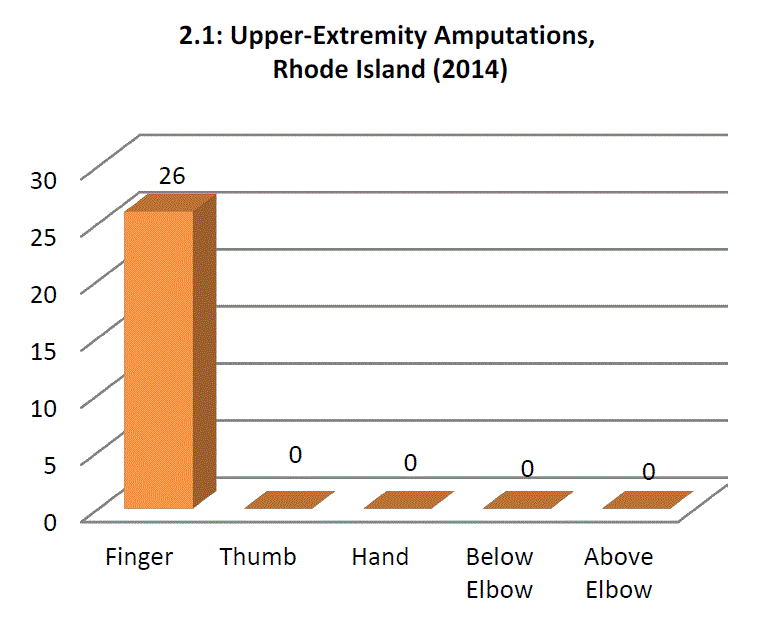
SOURCE: HEALTHCARE COST AND UTILIZATION PROJECT HCUPNET DATABASE HCUPNET.AHRQ.GOV
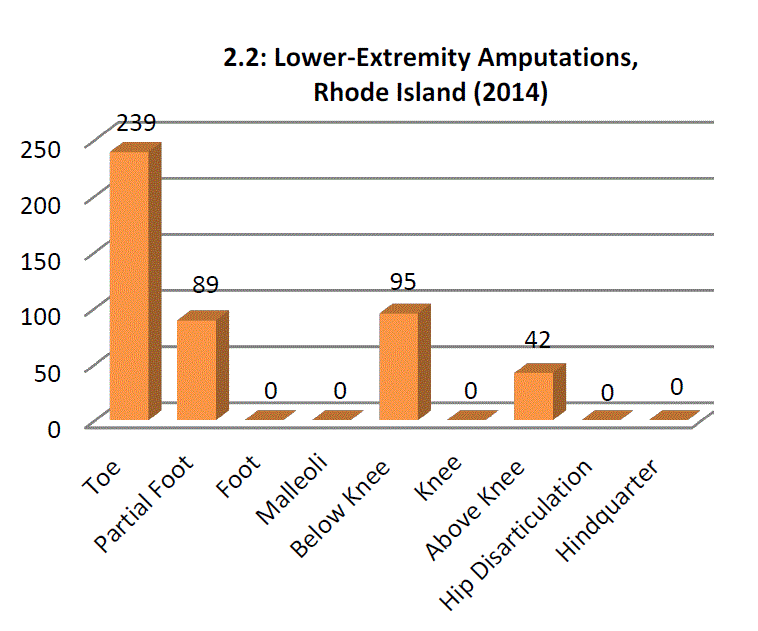
SOURCE: HEALTHCARE COST AND UTILIZATION PROJECT HCUPNET DATABASE HCUPNET.AHRQ.GOV
465 lower-extremity amputations were performed in 2014. In terms of minor lower-extremity amputations, toes (239) were amputated more often than part of the foot (89). For major lower-extremity amputations, below- knee (95) amputation was the most common procedure. (See Graph 2.2)
3. WHO LOSES A LIMB?
In 2014, most amputations were performed on individuals aged 45-64 years old, followed by the age group of 65-84 year olds (See Graph 3.1).
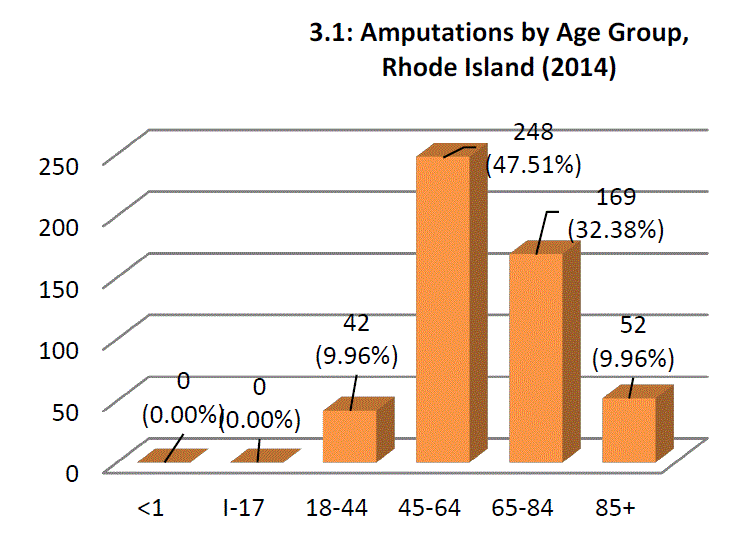
SOURCE: HEALTHCARE COST AND UTILIZATION PROJECT HCUPNET DATABASE HCUPNET.AHRQ.GOV
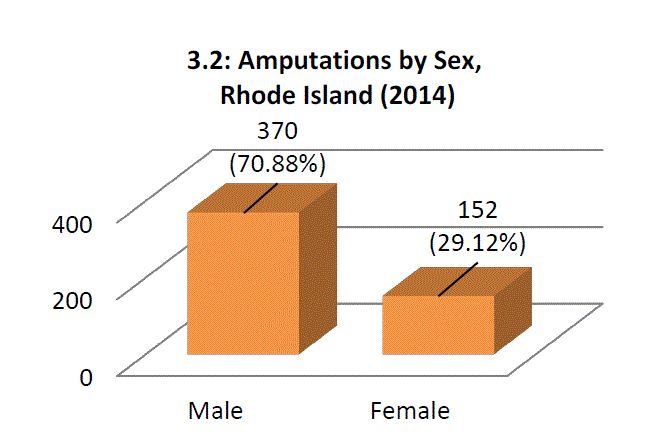
SOURCE: HEALTHCARE COST AND UTILIZATION PROJECT HCUPNET DATABASE HCUPNET.AHRQ.GOV
There were roughly 2.5 times more amputations performed on male patients in Rhode Island than on female patients (See Graph 3.2).
Medicare recipients ranked as the most common group to have an amputation procedure, followed by private insurance. (See Graph 3.3)
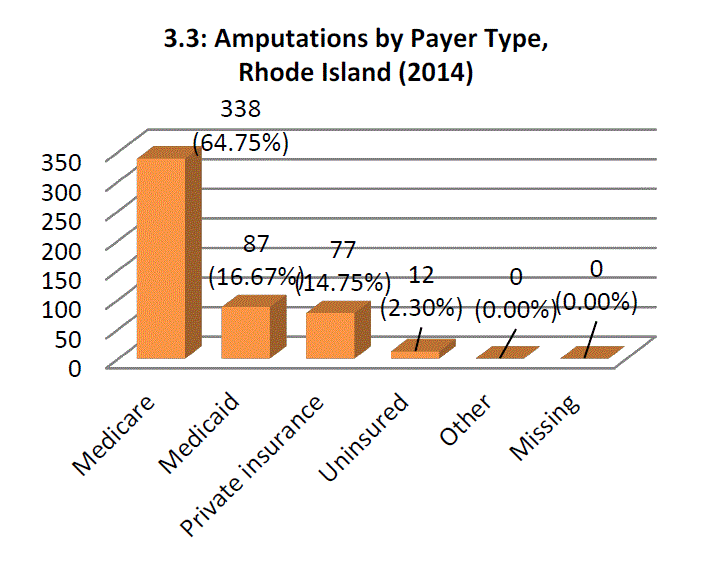
SOURCE: HEALTHCARE COST AND UTILIZATION PROJECT HCUPNET DATABASE HCUPNET.AHRQ.GOV
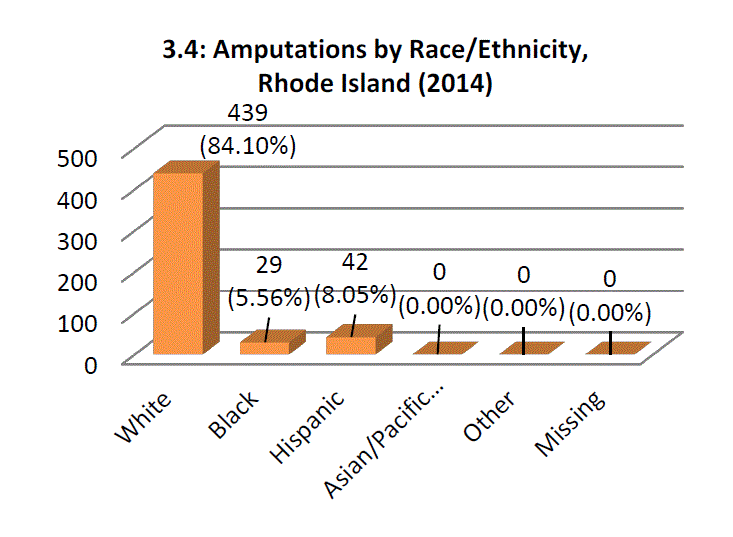
SOURCE: HEALTHCARE COST AND UTILIZATION PROJECT HCUPNET DATABASE HCUPNET.AHRQ.GOV
We can see that the African American population of Rhode Island bears the heaviest burden of amputation (0.072% of the African American population underwent amputations). This is evident when compared with the percentage of the white population that underwent amputations (0.043%), and with amputations in the state’s population as a whole (0.043%). (See Graph 3.4)
* According to Census Bureau estimation data (http://factfinder.census.gov/faces/tableservices/jsf/pages/productview.xhtml? src=CF), the population of Rhode Island in 2014 was about 1,053,252 and was made up of about 856,605 white residents and 66,827 African American residents.
4. DIABETES TRENDS
In 2014, a total of 79,160 Rhode Island residents indicated that they had been diagnosed with diabetes at some point in their lives. The prevalence of diabetes in the adult population of Rhode Island increased 125.71% from 1995 to 2014. (See Graph 4.1)
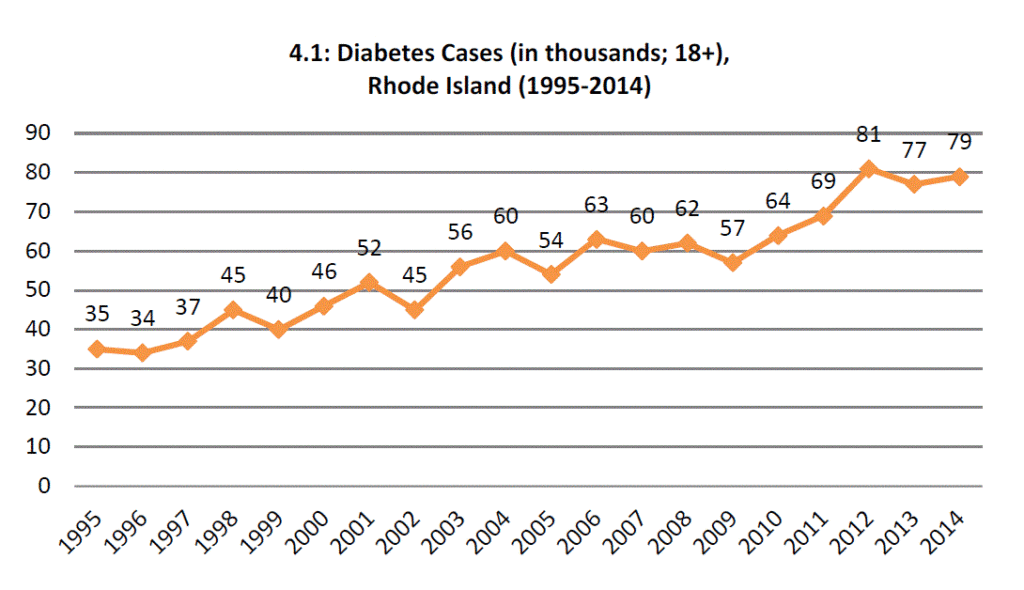
SOURCE: HEALTHCARE COST AND UTILIZATION PROJECT HCUPNET DATABASE HCUPNET.AHRQ.GOV
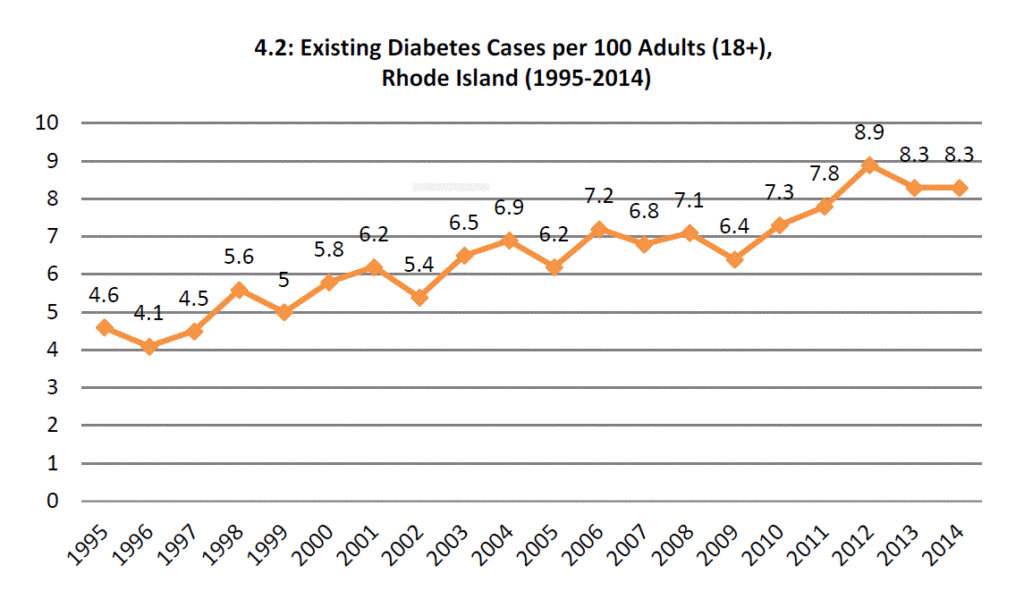
SOURCE: HEALTHCARE COST AND UTILIZATION PROJECT HCUPNET DATABASE HCUPNET.AHRQ.GOV
The annual rate of existing cases of diabetes among adults in Rhode Island increased 80.43% from 1995 to 2014. (See Graph 4.2)
5. HEALTHCARE COSTS
For persons with a unilateral lower-extremity amputation, the two year healthcare costs, including initial hospitalization, inpatient rehabilitation, outpatient physical therapy, and purchase and maintenance of a prosthetic device, is estimated to be $91,106. The lifetime healthcare cost for persons with a unilateral lower extremity amputation is estimated to be more than $500,000 (5). It is anticipated that these healthcare costs would be higher for a person with a proximal amputation level and bilateral amputation status, due to higher prosthetic costs.
Charges represent what the hospital billed for the case, and may not represent all discharges for amputations. (See graph 5.1)
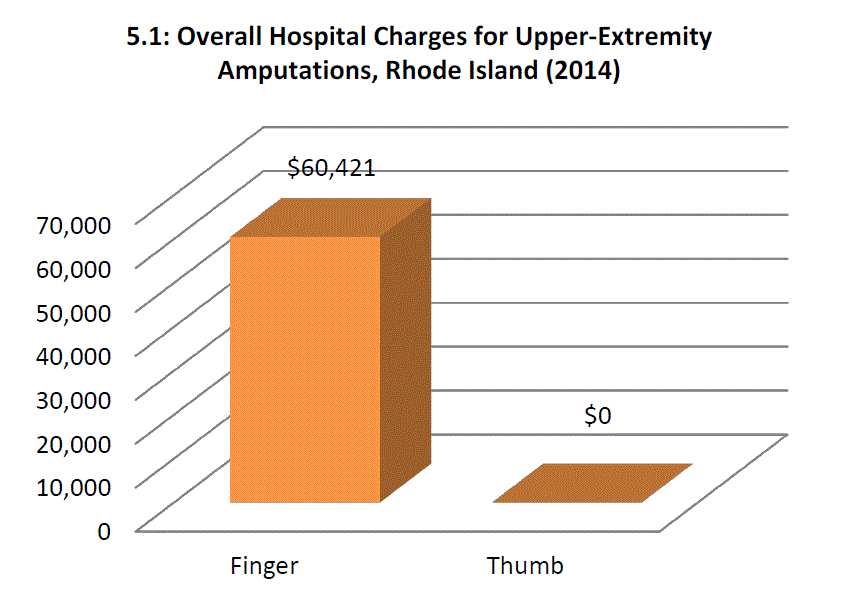
SOURCE: HEALTHCARE COST AND UTILIZATION PROJECT HCUPNET DATABASE HCUPNET.AHRQ.GOV
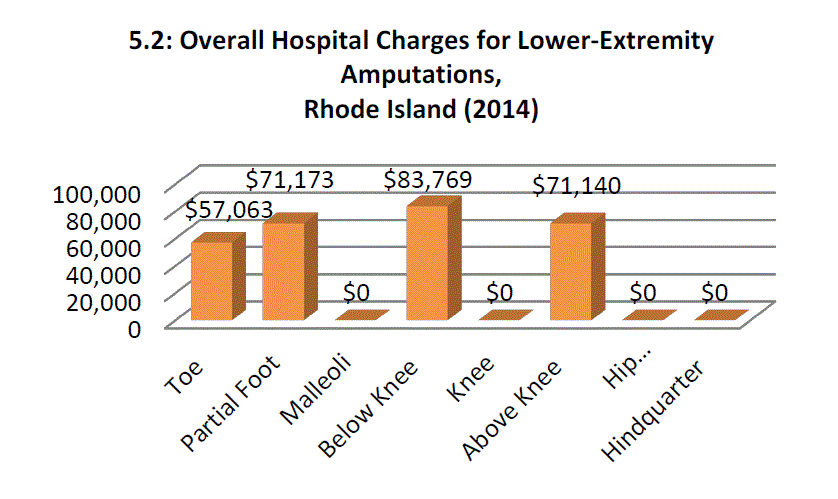
SOURCE: HEALTHCARE COST AND UTILIZATION PROJECT HCUPNET DATABASE HCUPNET.AHRQ.GOV
Charges represent what the hospital billed for the case, and may not represent all discharges for amputations. (See graph 5.2)
6. REFERENCES
- Ziegler-Graham K, MacKenzie EJ, Ephraim PL, Travison TG, Brookmeyer R. Estimating the Prevalence of Limb Loss in the United States: 2005 to 2050. Archives of Physical Medicine and Rehabilitation2008;89(3):422-9.
- Coalition LLTFA. Recommendations from the 2012 Limb Loss Task Force: Roadmap for Preventing Limb Loss in America. [White Paper]. 2012 February 9-12.
- Bryant PR, Pandian G. Acquired limb deficiencies. 1. Acquired limb deficiencies in children and young adults. Archives of Physical Medicine and Rehabilitation2001;82(3B):00s3-s8.
- Li Y, Burrows NR, Gregg EW, Albright A, Geiss LS. Declining Rates of Hospitalization for Nontraumatic Lower-Extremity Amputation in the Diabetic Population Aged 40 Years or Older: U.S., 1988-2008. Diabetes Care2012;35(2):273-7.
- MacKenzie EJ. Health-Care Costs Associated with Amputation or Reconstruction of a Limb-Threatening Injury. The Journal of Bone and Joint Surgery (American)2007;89(8):1685.
It is not the intention of the Amputee Coalition to provide specific medical or legal advice but rather to provide consumers with information to better understand their health and healthcare issues. The Amputee Coalition does not endorse any specific treatment, technology, company, service or device. Consumers are urged to consult with their healthcare providers for specific medical advice or before making any purchasing decisions involving their care.
© Amputee Coalition. Local reproduction for use by Amputee Coalition constituents is permitted as long as this copyright information is included. Organizations or individuals wishing to reprint this article in other publications, including other websites must contact the Amputee Coalition for permission to do so, by emailing a request to rc@amputee-coalition.org.



